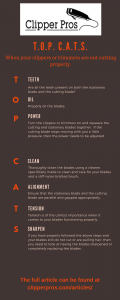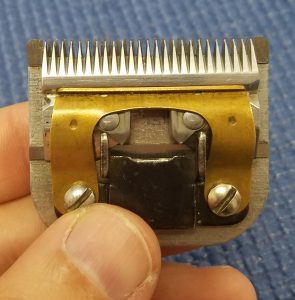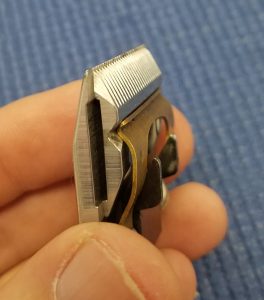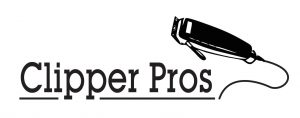Why won’t my blades cut, or why are my blades pulling hair?
We get asked “Why won’t my blades cut, or why are my blades pulling hair?” a lot, and sometimes it comes in the form of a statement, “My clipper/trimmer blades quit cutting/started pulling hair, so I threw them (“them” being the blades and sometimes the entire clipper/trimmer!) away.” We HATE hearing about people throwing their money away, because 9 out of 10 times we can help you get your blades cutting again for much less than a new blade and CERTAINLY much less than a new clipper/trimmer. The time that we can’t get your blades cutting again, the blade is trashed and does need to be RECYCLED. Don’t just toss your blades, please recycle them.
So, how does someone get a blade that is not cutting or is pulling hair to start cutting again? Just follow T.O.P. C.A.T.S.

T. = Teeth
O. = Oil
P. = Power
C. = Clean
A. = Alignment
T. = Tension
S. = Sharpen
T. = Teeth
The first check that you do is on the teeth of the blades. Are all the teeth still on the stationary blade? Are all the teeth still on the cutting blade? Are all the teeth straight? If you are missing teeth, then you should seriously consider replacing the blade. If you still have all the teeth, then move to the next step.
O. = Oil
Yep, this is the one that gets a lot of people. For some reason oiling the blades is something that people refuse to do when this one step will save you more money than anything else. It keeps your blades functioning properly and keeps them from wearing out as quickly. Go here to read about the correct way to oil your blades.
P. = Power
Your third check will be the power of the clipper/trimmer. Is there enough power to move the cutting blade fast enough to cut? Turn the tool on and pinch the cutting blade and the stationary blade together. If you can stop the cutting blade with very little pressure, then your power is too weak, and you will need to clean out your tool and/or adjust the power (upcoming article).
C. = Clean
If all the teeth are present and your power is good, then you will need to clean your blades. Carefully remove the blades from the clipper/trimmer. Thoroughly clean the blades using a cleaner specifically made to clean and care for your blades and a stiff nylon bristled brush. We use and highly recommend the cleaner and disinfectant H-42. Ensure that ALL hair and dirt has been removed from the blades and from between the teeth of the blades. Dry the blades with a towel and reassemble the blades. Also, inspect for rust BETWEEN the teeth. You do this after you have thoroughly cleaned the blades because you do not want to replace a blade that was simply dirty and not rusty. If there is rust damage between the teeth, then you will need to replace the blade. The rust dulls your blades and will continue to dull the blades even if they are sharpened.
A. = Alignment
After cleaning your blades, then you MUST align the blades or they will not cut properly no matter how clean and shiny they are. Ensure that the stationary blade and the cutting blade are parallel and gapped appropriately (Upcoming article). Each clipper/trimmer cuts better at different gappings because of how they are designed, but ALL clipper and trimmer blades MUST be parallel to cut correctly. Do not look through the teeth (Picture A). Turn the blade to the side so that they teeth lineup which makes it easier for you to gap (Picture B).
 (Picture A – WRONG WAY!)
(Picture A – WRONG WAY!)
 (Picture B – CORRECT WAY!)
(Picture B – CORRECT WAY!)
T. = Tension
Tension is of the utmost importance when it comes to your blades functioning properly. ALL blades have some form of tension forcing the cutting blade against the stationary blade. If this tension is too much, then the cutting blade will not move or will move poorly. If your tension is too little, then the blades will rattle, will pull hair, or will clog up with hair stuck between the blades which will stop the cutting blade from moving/cutting. Either way your tool will not cut properly. (Upcoming article)
S.= Sharpen
Finally, if you have properly followed the above steps and your blades still do not cut or are pulling hair, then you need to look at having the blades sharpened by someone who knows what they are doing or completely replacing the blades. We suggest getting your blades sharpened as many times as possible before replacing them with new blades. This saves you money and saves on blades being thrown away (or preferably recycled). Blades that have been sharpened by a professional who knows what they are doing will cut as well as a new blade (sometimes better) and will hold that edge just as long as a new blade.
Now if you hear anyone ask, “Why won’t my blades cut, or why are my blades pulling hair?” you can tell them to follow T.O.P. C.A.T.S. and help them diagnose the problem.
Finally, T.O.P. C.A.T.S. is not just for old blades that are not cutting. You should apply the same steps after you get back your sharpened blades or after getting a new blade. The companies that produce blades do make mistakes sometimes, as do professional sharpeners, and at a minimum, you will need to align the blades properly before using them.

